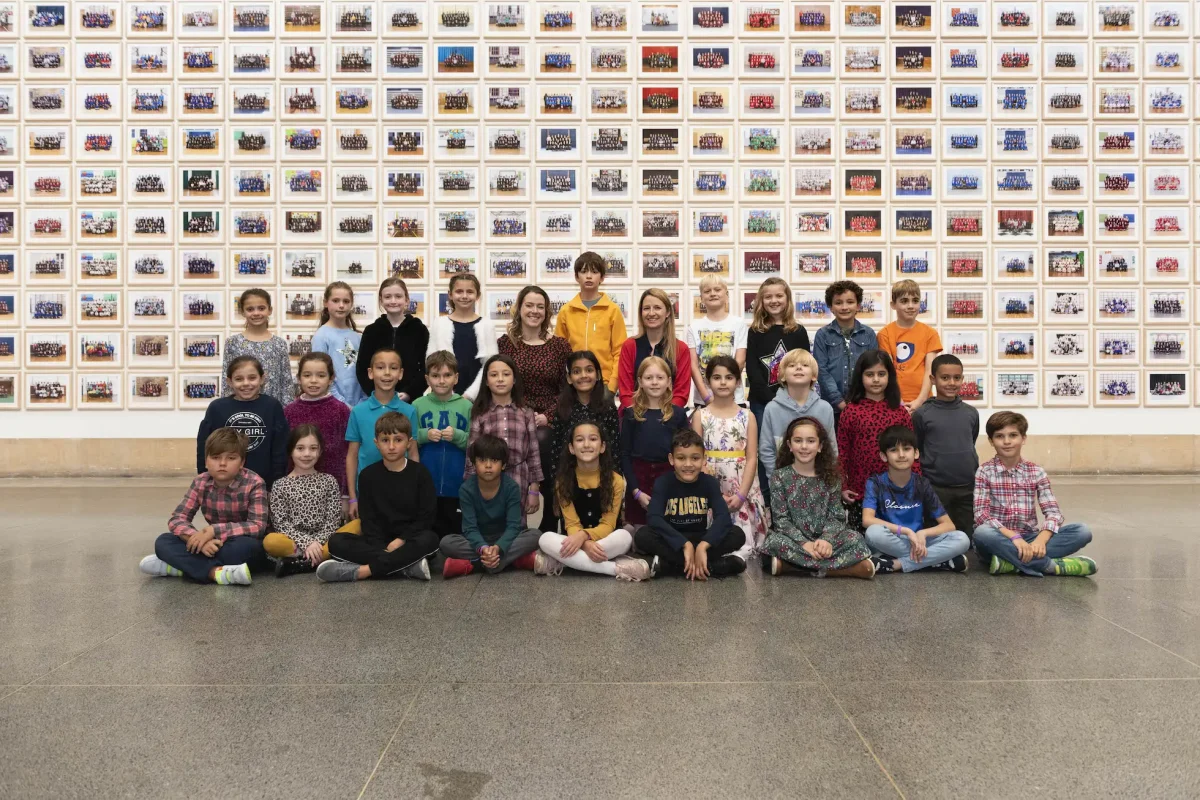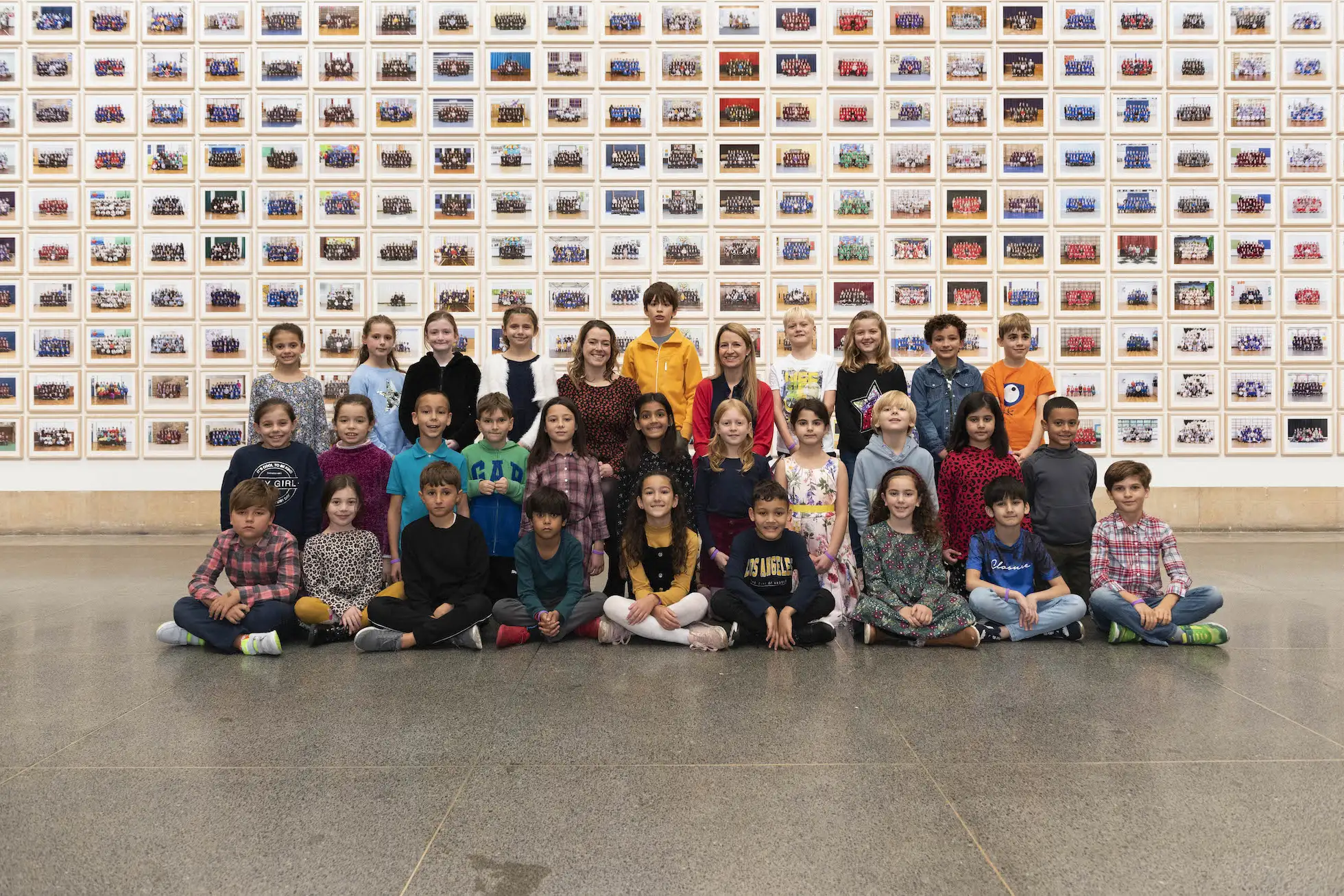Tens of thousands of Year 3 pupils become part of a celebrated contemporary art project

Credit: Little Ealing Primary visiting Steve McQueen Year 3 at Tate Britain © Tate. Photo David Lennon
This case study tells the story of one Turner-Prize winning artist and 76,000 school children across London: the journey of Steve McQueen’s Year 3 project at Tate Britain. Written by A New Direction.
This is one of 25 case studies highlighting the value of arts in schools and education settings, curated by arts education researcher Sarah B Davies. The suite of case studies illustrates the research The Arts In Schools: Foundations for the Future, by Pauline Tambling and Sally Bacon, due to be published in 2023.
About the project
In September 2018, as part of an ambitious project created by London-born Turner Prize-winning artist and Oscar-winning filmmaker Steve McQueen, partners Tate, Artangel and A New Direction invited every primary school in London to be part of a giant collective portrait, capturing tens of thousands of Year 3 schoolchildren in a milestone year in their development. The photos would come together in a major new artwork as an epic picture of the city’s present and an intimation of its future.
Year 3 is considered a milestone year in a child’s development and sense of identity, when 7 and 8 year-olds become more conscious of a much bigger world beyond their immediate family. Steve McQueen’s project captures this moment of excitement, anticipation and hope through the medium of the traditional class photograph, with rows of children sitting or standing alongside their teachers.
Ahead of the opening of Year 3 at Tate Britain on 12 November 2019, class photographs of Year 3 schoolchildren were displayed on over 600 billboards across London’s 33 boroughs in a city-wide outdoor exhibition organised by Artangel.
Photography sessions of each class included a workshop about the project and its themes, with further cross-artform full day workshops available to the first 100 schools that acted as Ambassadors for the programme, exploring the themes of identity, community and the future. Many of the activities from these workshops were made available to teachers to use through the Learning Lenses resource which is still available on A New Direction’s website.
Following the project, a series of nine essays were commissioned by A New Direction to reflect on the Tate Year 3 Project from different perspectives and provoke thinking about future projects. Together, the essays explored the themes of representation, entitlement, access, collaboration, and risk.
What worked well
Subjects of artwork should always have a positive experience of the process, but when those subjects are 7 and 8 year-olds, and there are over 76,000 of them featuring in a national gallery, the need for it to be meaningful participation becomes even more important. Through our role in the Tate Year 3 Project, A New Direction worked hard to make this happen.
At every stage of the project, we developed an engaging range of workshops for the children that involved explaining the project so they could understand what their image would be a part of and exploring the themes so they could express their own ideas on identity, community, the future and the place of art in their lives. This led to workshops and some insightful discussions, often with teachers being delighted and surprised at seeing another side to their pupils. It enabled the children to become active participants in the artwork they are at the heart of, and because they were having fun, we got big grins for the photo too.
We recruited and trained nine photographers who attended multiple schools each per day to capture the class photos. To ensure quality experiences, we provided written resources and initial briefings for the Tate photographers with experienced creative practitioners, followed by weekly CPD from A New Direction staff with teaching experience. CPD covered a range of topics and techniques to ensure good partnership working with teachers and support staff before and during workshops, effective questioning skills, use of visual aids, inclusive practice and working with Special Educational Needs and Disabilities (with support from our SEND Network).
Kerri Sellens, Assistant Head and Curriculum Lead at Lansbury Lawrence Primary School, echoed a view we heard from many teachers about how important the additional activities were to the photography sessions, saying: “The children enjoyed learning about photography through interacting with the photographer and loved the drama activities accompanying the session to encourage deeper thinking about why our community is special.”
Following the initial year of photography in 2018/2019, the exhibition opened with bookable slots open to all schools that had taken part. Classes were able to view their photo up close on a screen, and shown their photo situated in the gallery too (though some eagle-eyed students managed to somehow spot the picture themselves, first!). It was interesting seeing staff and students having similar reactions of awe at how similar the pictures could be, and yet so different once you got up close – in class size, uniform colour, and individual expressions.
What was challenging
With a project aiming to represent London’s 7 and 8 year-olds it was critical that we made every effort to be as inclusive as possible. The importance of this was beautifully summed up by Danielle Barker, headteacher of Northway School, a special school in Barnet, who said:
“Northway loved taking part in the Year 3 project. We see the project as a platform to showcase our wonderful children; it is so important to us that SEND children are not invisible, that they are recognised as part of the community and are visible in a range of public venues. We ensure that our pupils have the opportunity to have a range of experiences just as their mainstream counterparts do, so what better way than getting involved in a project like this.”
Given the extra considerations for SEND schools to take part, we made a particular effort to contact them by phone to explain the project and maximise the number taking part. Before each session in a SEND school, the photographer was put in touch with the class teacher to talk through how best to adapt our activities to their particular students. For example, some schools had shorter workshops with sensory focused games that helped create a sense of community between children who might not usually collaborate in lessons.
Another major challenge of the project were the additional logistics and safeguarding considerations involved in displaying children’s images in the Outdoor Exhibition on billboards across London. NSPCC provided expert advice and following this, special effort was taken to ensure school photos did not appear in their own borough or neighbouring boroughs, all identifying features e.g. logos were removed, and criteria for billboard locations was carefully checked. Schools were told the locations of their billboards in strictest confidence so they could take their own classes to see them without publicising them more broadly. In preparation for the Outdoor Exhibition, A New Direction ran extra workshops for all classes due to appear on a billboard, again to ensure pupils understood what they were part of and could explore what it meant to have their image in the public domain, something that tied into school commitments to e-safety.
What can others learn?
The key thing we are most proud of is how central young people remained to such a large scale project, something which took considerable thought and effort from the planning stage onwards, manageable systems consistently applied to ensure we could do this at scale, and close partnership working with schools and class teachers in particular. Understanding the school context was essential to the success of this project.
Many young people described how special it made them feel and took the theme of community particularly to heart. One pupil said: “I am really proud to be in the Tate Britain and on a billboard. I love being shown to London and I am proud to have the chance to be in the Tate.” Another felt it brought his class closer together saying, “When the photographers came it made me feel like my class were a big family.” Even months on from the photographer visits, children had lasting positive impressions, such as: “I like how it wasn’t a boring photo thing, they made it into a fun game.”
There was a significant impact on teachers, best summed up by one West London teacher who said:
“For all of us it is very exciting to appear in one of the most famous galleries in the world and be a part of a snapshot in time and appear with others. The idea of school photos traditionally kept in boxes looked at after decades coming off the mantelpiece and into a gallery in their thousands encourages a shift in my perception, from the individual to the societal and the present and future that is offered to children. It has made me reflect on my role as a teacher and the need to teach the whole child, much more than the curriculum!”
Above all for the cultural sector, the key lessons explored in more depth in the nine essays reflecting on the project are about the importance of taking considered risks, planning for and acting in partnership both within large organisations and across multiple partners, and young people’s entitlement to not only access but be at the heart of our culture.




